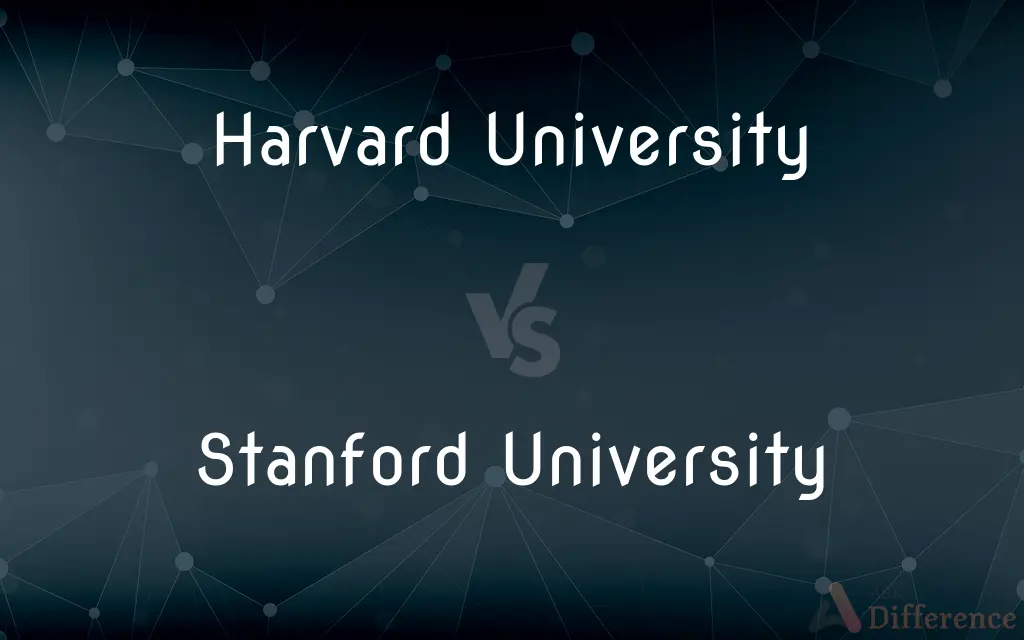Harvard University vs. Stanford University — What's the Difference?
By Tayyaba Rehman & Urooj Arif — Published on February 14, 2024
Harvard University, established in 1636 in Cambridge, Massachusetts, is the oldest higher education institution in the U.S. Stanford University, founded in 1885 in Stanford, California, is known for its strength in technology and entrepreneurship.

Difference Between Harvard University and Stanford University
Table of Contents
ADVERTISEMENT
Key Differences
Harvard University and Stanford University are two of the most prestigious institutions of higher education in the United States, each with its own distinct identity, history, and strengths. Harvard, located in Cambridge, Massachusetts, is renowned for its long history, having been established in 1636, making it the oldest institution of higher learning in the United States. It boasts a vast library system, a strong focus on law, business, and medical fields, and a rich tradition in liberal arts education.
Stanford University, situated in the heart of Silicon Valley in California, was founded much later in 1885 by Leland and Jane Stanford in memory of their only child. It is celebrated for its entrepreneurial spirit, strong engineering and computer science programs, and significant contributions to the tech industry. Stanford's location offers unique advantages to students interested in technology and startups, fostering a culture of innovation and collaboration.
The campuses of both universities are iconic; Harvard’s historic buildings and ivy-covered walls embody the quintessential East Coast college experience, while Stanford’s sprawling, palm-lined campus and Mediterranean architecture reflect its West Coast setting. Both institutions attract students from all over the world and are involved in extensive research activities, offering numerous academic programs and extracurricular opportunities.
In terms of selectivity, both Harvard and Stanford are highly competitive, with low acceptance rates and rigorous admissions criteria focusing on academic excellence, extracurricular achievements, and character. Financial aid policies at both universities ensure accessibility to talented students from diverse socioeconomic backgrounds, making them two of the most sought-after universities globally.
While Harvard is often associated with a strong liberal arts education, producing numerous U.S. presidents and global leaders, Stanford is recognized for its entrepreneurial ethos, contributing to the birth of companies like Google and Hewlett-Packard. Ultimately, the choice between Harvard and Stanford may come down to personal preference, academic interests, and career aspirations.
ADVERTISEMENT
Comparison Chart
Founded
1636
1885
Location
Cambridge, Massachusetts
Stanford, California
Strengths
Liberal arts, law, business, medical
Engineering, computer science, entrepreneurship
Campus
Historic East Coast setting
Sprawling West Coast campus
Notable for
Producing U.S. presidents, vast library system
Proximity to Silicon Valley, fostering startups
Compare with Definitions
Harvard University
Strong focus on law and business education.
Graduates from Harvard's law and business schools often lead successful careers globally.
Stanford University
Offers a sprawling campus in California.
The Stanford University campus is known for its distinctive architectural style and palm trees.
Harvard University
A leader in liberal arts education.
Harvard University's liberal arts programs are designed to foster broad intellectual growth.
Stanford University
Founded in memory of Leland Stanford Jr.
Stanford University's foundation was inspired by personal tragedy and hope.
Harvard University
Oldest higher education institution in the U.S.
Harvard University's extensive history is reflected in its comprehensive archives.
Stanford University
Cultivates a culture of innovation.
Stanford University encourages students to think creatively and solve complex problems.
Harvard University
Located in Cambridge, Massachusetts.
Harvard University's urban campus is intertwined with historic Cambridge.
Stanford University
Renowned for its strength in technology and entrepreneurship.
Stanford University is at the forefront of innovation in Silicon Valley.
Harvard University
Known for its extensive library system.
Researching at Harvard University offers access to millions of volumes and rare collections.
Stanford University
Contributes significantly to the tech industry.
Many tech industry leaders got their start at Stanford University.
Common Curiosities
Which university is older, Harvard or Stanford?
Harvard University, founded in 1636.
Are Harvard and Stanford both Ivy League schools?
Only Harvard is an Ivy League school.
Which university is better for engineering, Harvard or Stanford?
Stanford is generally regarded as stronger in engineering.
Can I study business at both universities?
Yes, both offer prestigious business programs.
Is Silicon Valley associated with Harvard or Stanford?
Silicon Valley is closely associated with Stanford University.
Which university offers more startup opportunities?
Stanford, due to its proximity to Silicon Valley.
Which university is located near Boston?
Harvard University.
Are both universities private?
Yes, both are private institutions.
Which university has produced more U.S. presidents?
Harvard University.
Which university has a larger campus?
Stanford University has a larger campus.
How competitive are admissions at Harvard and Stanford?
Both are extremely competitive with low acceptance rates.
Do both universities have a medical school?
Yes, both have highly regarded medical schools.
Do both universities offer financial aid?
Yes, both offer need-based financial aid.
Which university is better for computer science?
Stanford is highly regarded for its computer science program.
Can international students apply to both universities?
Yes, both universities welcome international applicants.
Share Your Discovery

Previous Comparison
Spain in Football vs. Portugal in Football
Next Comparison
Bamboo Flooring vs. Hardwood FlooringAuthor Spotlight
Written by
Tayyaba RehmanTayyaba Rehman is a distinguished writer, currently serving as a primary contributor to askdifference.com. As a researcher in semantics and etymology, Tayyaba's passion for the complexity of languages and their distinctions has found a perfect home on the platform. Tayyaba delves into the intricacies of language, distinguishing between commonly confused words and phrases, thereby providing clarity for readers worldwide.
Co-written by
Urooj ArifUrooj is a skilled content writer at Ask Difference, known for her exceptional ability to simplify complex topics into engaging and informative content. With a passion for research and a flair for clear, concise writing, she consistently delivers articles that resonate with our diverse audience.













































